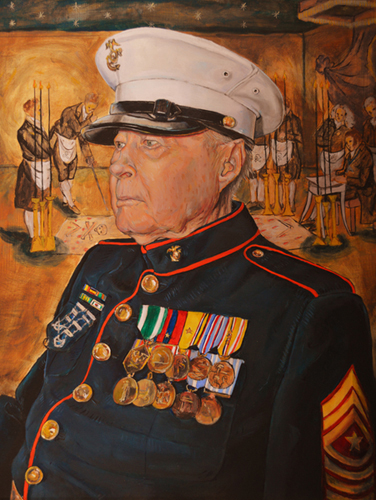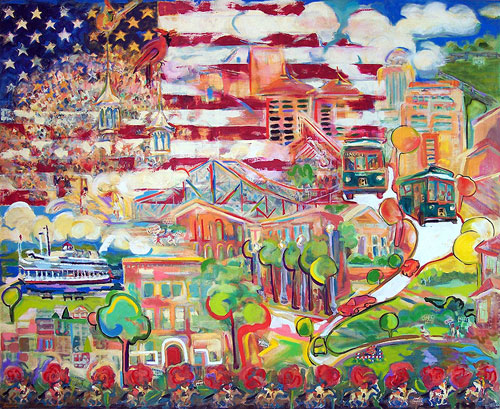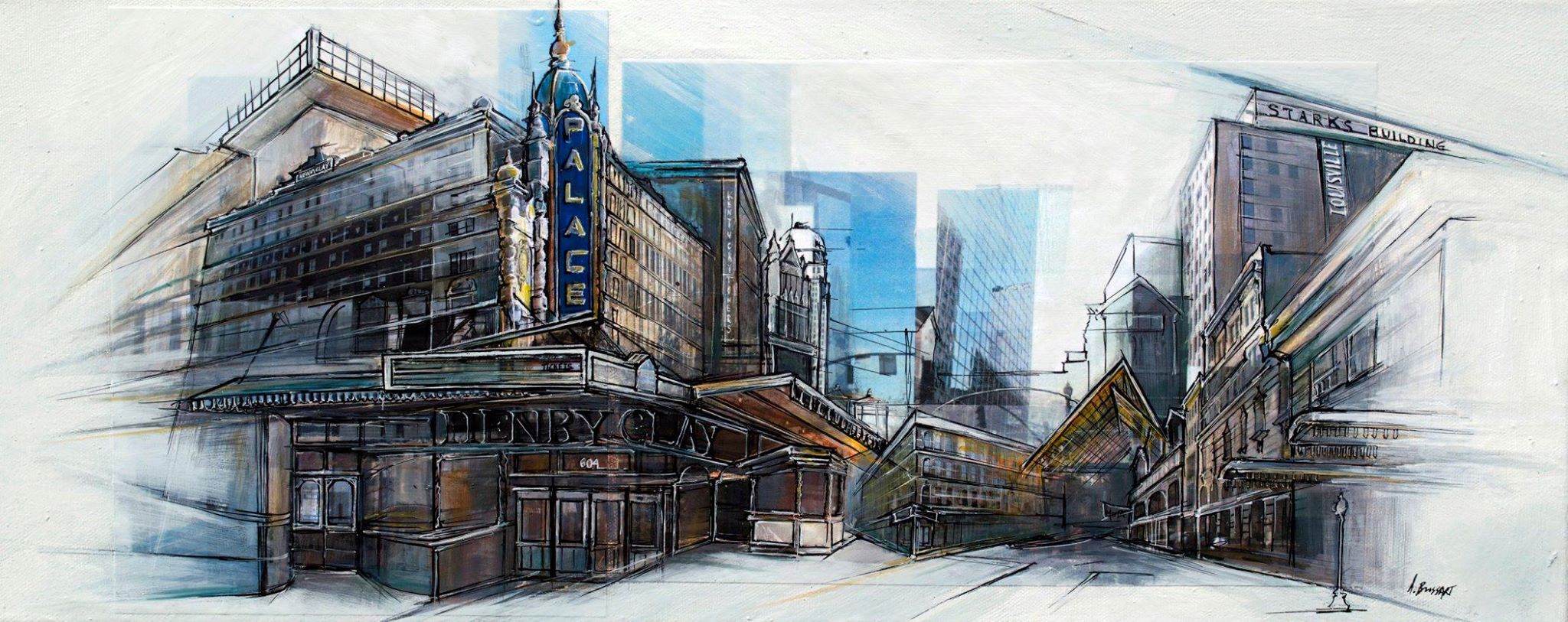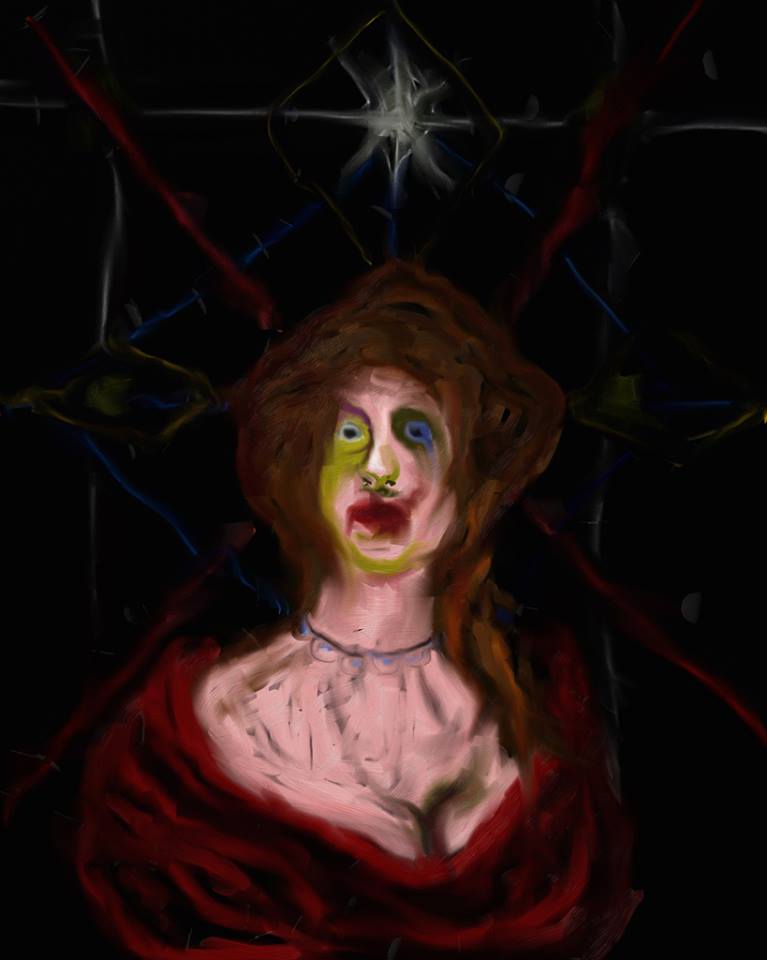Struggle and Triumph
Curated by Slade Stumbo, featuring the work of Joyce Garner, Mark Priest & Jordan Lance Morgan
Reviewed by Kaylyn Taylor.
Entire contents are copyright © 2013, Kaylyn Taylor. All rights reserved.
Since September of 2013, the Louisville Visual Arts Association (LVAA), the Louisville Commission on Public Art and the Mayor’s office have collaborated to present the Metro Hall Rotunda Art Project. This “rotating series of art exhibits, each one curated by local artists…is specifically for the public spaces of Metro Hall” and is “one of several efforts to make Metro Hall a true gathering place for the community.” (Curtis Tate, WAVE3.com) “Struggle and Triumph,” curated by Slade Stumbo, features the paintings of local artists Joyce Garner, Mark Priest and Jordan Lance Morgan. It is the third exhibition of the Metro Hall Rotunda Art Project and will be on display through November 1, 2013.
| Joyce Garner, Local Politics, 2013. |
On the first floor of Metro Hall, Garner’s brightly colored works from her extensive series “The Election” are displayed. Six of her seven canvases selected for this exhibit are carnival and circus themed. The canvases, ranging in size from 30”X36” to 84”x54”, are filled from edge to edge with color and images, creating a flattened, busy space. The figures are curvilinear loose images that float in the picture plane. The colors and forms suggest Peter Max meets Chagall and Picasso, creating a fantastic explosion of information, mirroring the overwhelming glut of information that floods daily life during election season.
With an almost neon color palette, and the iconography of carnivals and circuses, Garner conveys the frenetic, intense energy of our country’s election process from the primary elections, represented by a carousel, to the final election results, as seen in “Sittin’ Pretty.” The carousel is an effective commentary on the cyclical and showy aspects of the election process. As in circuses and carnivals, the candidates perform crowd-pleasing acrobatics composed of promises and offer elixirs to cure our societal ills. “Belly Flop” reminds that sometimes there are failures, and they are fantastic when magnified by the media. The canvas “Sittin’ Pretty” shows a single carousel horse with its rider perched atop a sphere of fruit galore: the Victor. Out of the chaos and frenzy one endures to the end. Garner’s canvas “Local Politics” is an array of Louisville landmarks and events, ranging from cardinal birds to the Twin Spires, from the Orchestra to Louisville’s cityscape. These familiar images are set against a background of the American flag, reminding that the local and the national are closely knit.
Located at the top of the grand staircase leading from the second floor rotunda is Mark Priest’s “Drop Him, Catch Him.” This large canvas (8’x4’7”) depicts the attempted escape of the recaptured runaway slave Charles Nalle. Nalle is shown hanging precariously from a second story window of a brick building. The viewer’s perspective is looking down from slightly above Nalle’s eye level. Below him a crowd gathers, and inside the room from which he is escaping, authoritative figures dominate the area. The composition captures the drama of the story. The viewer is on par with Nalle and his plight. Through the use of exaggerated facial expressions and fluid lines, the multiple facets of the scene are explained. Clearly the man behind Nalle intends to capture him. The crowd gathering below is grotesque in its fascination. The woman in the room behind Nalle is defeated. A lone pigeon tugs at Nalle’s pant leg, delineating the delicacy of his chances of freedom. The color palette is earthy but bright, leaving the action clear and dramatic. The central figure of Nalle is strong but vulnerable. Priest places the viewer directly in the experience of being oppressed, and we are forced to consider how that feels.
 |
| Mark Priest, Drop Him, Catch Him, 2013. |
Continuing up the staircases, on either side are additional Priest paintings. On one side are two paintings from his Harriet Tubman series: “Leverton Safe-House” and “The Wait.” These are psychological pieces. In both, the focus is on the upper torso and face of two men and Harriet Tubman attempting an escape from slavery. Again, the clarity of the earthy color palette draws the viewer in. There is no lurking in shadows and skulking about. The intention of these people to escape is evident, yet their cautious, dubious facial expressions reveal their vulnerability. We are eye level with these people, and are one of them.
The fourth of Priest’s paintings, “ Bailey’s Escape on the Choptank,” is also from his Harriet Tubman and the Underground Railroad series. It depicts the escape of Josiah Baliey from slavery by boat. In this painting, he and three other figures are navigating rough waters. Josiah is in the foreground, pointing ahead, while two other figures steer the boat. The fourth figure dramatically swoons over the boat’s side. The viewer is set a bit farther back from the action than in Priest’s other works, but the drama holds. Through the strong use of diagonal composition the energy of the piece is unbalanced yet purposeful. Priest creates vivid snapshots of action that is unresolved, thus compelling the narrative forward. We are privy to the humans involved in dire circumstances, and we are asked, again, to reflect on what this moment must have been like.
Located on the third floor are a series of six portraits by Jordan Lance Morgan. Three of these represent specific members of the armed services: one is a self- portrait, and the remaining two are of George Washington and Benjamin Franklin. The historical figures are rendered in oil on linen, while the rest are oil on panel. Compared to Priest and Garner, Morgan’s works are small in scale, ranging in size from approximately 12”x18” to 24”X18”. However, the impact of these works is no less.
,+2013.jpg) |
| Jordan Lance Morgan, Portrait of Sargent Major Thomas B. Crump (USMC), 2013. |
Morgan states, “While my paintings reflect a desire for realism, my main concern is to emphasize the tension between the illusion of volume and the flat picture plane…”(http://www.louisvilleky.gov/Mayor/News/2013/7-25-13struggleand+triumphexhibit.htm)
In his portraits of contemporary military personnel Morgan places superb realist renditions of persons against a flat, image-filled background. The portrait work effectively brakes the two dimensional plane, and the viewer is tempted to reach out and touch the figure. Adding to the interest and sophistication of the renderings is the iconography that surrounds the figures. Medieval knights, Biblical references, skull and crossbones, and Freemason’s square and compass lend mysterious clues to the significance of the individual. These symbols are painted in an illustrative, rather than realist, manner. The juxtaposition of these two styles speaks to Morgan’s skills and vision. The figurative work moves beyond the picture plane, not because of the background, but in spite of it. We are offered realism with its accompanying story in a single image.
“Martyrdom Of the Master,” oil on panel, again juxtaposes realism with illustration, to a Francis Bacon kind of effect. The figure represents the artist as the architect of the Temple of Solomon. The body of the artist is nude, and essential organs are exposed, while the Temple is in mid construction. This is a visual puzzle in a surrealist vein, rendered beautifully.
Morgan’s historical portraits are compositionally similar to his other pieces. The upper torso and head are the focus of the work and are rendered realistically. However, while the backgrounds are flat, they are mostly tonal studies, with just a few Masonic symbols and Roman numerals to offer clues about the subjects themselves. There is a double entendre, as both George Washington and Ben Franklin are historical figures and symbols of America.
As an ensemble, the works of these three artists relate to each other through the “Struggles and Triumphs” that are being told. While other areas of the world struggle to establish a thriving democracy, Garner’s “Election Series” comments upon the struggles and victories inherent in the process of a vibrant democracy in action. Priest’s compelling exploration of the human spirit in the face of oppression speaks to individual victories, as well as the triumph of this country to remain united. Garner’s portraits offer insights into the founders of this democracy, and stories of individuals who now protect this hard earned union.
Struggle and Triumph
Joyce Garner, Mark Priest & Jordan Lance Morgan
Through November 1, 2013
Louisville Metro Hall
601 Jefferson Street
Louisville, KY 40202
Monday – Friday, 8:30 a.m. – 4:30 p.m.





